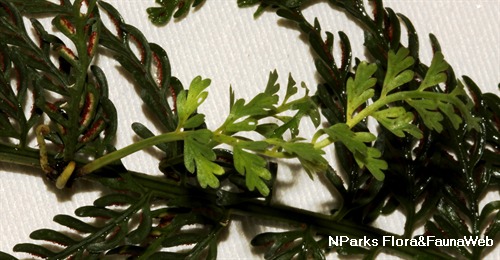
Back
Asplenium thunbergii Kunze
| Family Name: | Aspleniaceae |
| Synonyms: | Asplenium preussii ([Bory] Kunze) |
Name
Classifications and Characteristics
| Plant Division | Ferns & Lycophytes (Non-Seed Vascular Plants) (Fern) |
|---|---|
| Plant Growth Form | Herbaceous Plant |
| Lifespan (in Singapore) | Perennial |
| Mode of Nutrition | Autotrophic |
Biogeography
| Native Distribution | India (Assam), Sri Lanka, Vietnam, Thailand, Peninsular Malaysia, Borneo, Sumatra, Java, Sulawesi, Lesser Sunda Islands, Maluku, New Guinea, Philippines, Madagascar. |
|---|---|
| Native Habitat | Terrestrial |
| Preferred Climate Zone | Tropical |
| Local Conservation Status | Non-native |
Description and Ethnobotany
| Growth Form | Short, erect rhizome, up to 10 mm thick. |
|---|---|
| Foliage | Fronds are tufted and more prolific near the apex. Lamina bipinnate to tripinnate, elliptic in outline, can grow up to 20 cm long. Stipes between 7 - 20 cm long, brown and minutely scaly. |
| Others - Plant Morphology | Sori along veins, located further back half of the ultimate segments, indusia thin and firm. |
| Etymology | Genus Asplenium means without spleen and is usually a reference for the fern to cure spleen ailments. Species thunbergii is named after Swedish physician and professor, Carl Per Thunberg (1743 - 1822). |
Landscaping Features
| Desirable Plant Features | Ornamental Foliage |
|---|---|
| Landscape Uses | Interiorscape/ Indoor Plant, Container Planting, Parks & Gardens, Small Gardens |
Fauna, Pollination and Dispersal
| Seed or Spore Dispersal | Abiotic |
|---|
Plant Care and Propagation
| Light Preference | Semi-Shade |
|---|---|
| Water Preference | Moderate Water |
| Rootzone Tolerance | Moist Soils, Well-Drained Soils |
| Propagation Method | Spore |
Foliar
| Foliage Retention | Evergreen |
|---|---|
| Mature Foliage Colour(s) | Green |
Non - Foliar and Storage
| Specialised Storage Organ(s) | Underground |
|---|
Image Repository
Others
| Master ID | 29276 |
|---|---|
| Species ID | 3585 |
| Flora Disclaimer | The information in this website has been compiled from reliable sources, such as reference works on medicinal plants. It is not a substitute for medical advice or treatment and NParks does not purport to provide any medical advice. Readers should always consult his/her physician before using or consuming a plant for medicinal purposes. |









.jpg)
.jpg)
.jpg)
.jpg)



.jpg)